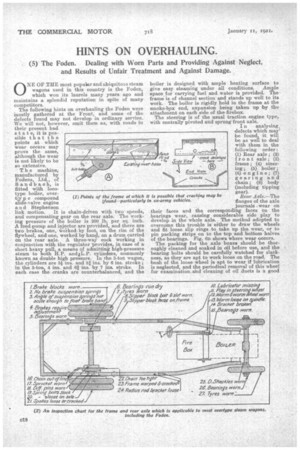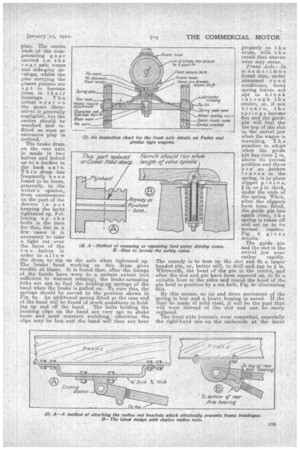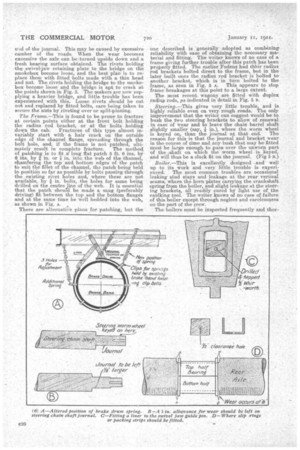HINTS ON OVERHAULING.
Page 16

Page 17

Page 18

Page 19

If you've noticed an error in this article please click here to report it so we can fix it.
(5) The Foden. Dealing with Worn Parts and Providing Against Neglect, and Results of Unfair Treatment and Against Damage.
0 NE OF THE most popular and ubiquitous steam wagons used in this country is the Foden, which won its laurels many years ago and maintains a splendid reputation in spite of many competitors.
The following hints on overhauling the Foden were Mostly gathered at the Front, and -some of the defects found may not develop in ordinary service. We will not, however, omit them as, with roads in their present bad state it is pos
sible that the points at which
Wear occurs may prove the same, although the wear is not likely to be so extensive.
T h e machine, manufactured by Foderis, Ltd., of Sandbaoh, is fitted with loco type boiler, overtv p e compound slide-valve engine and Stephenson link motion. It is chain-driven with two speeds, and compensating gear on the rear axle. The working pressure of the boiler is 200 lb. per sq. inch. A feed pump and injector are provided, and there are two brakes, one, worked-by foot, on the rim of the flywheel; and one, worked by hand, on a drum carried on the rear axle. A three-way cock working in conjunction with the regulator provides, in case of a short heavy pull ,a means of admitting high-pressure steam to both H.P. and,11.4.P. cylinders, commonly known as double high pressure. In the 3-ton wagon, the cylinders are ai ins, and 51 ins. by 6 ins. stroke; in the 5-ton, 4 ins. and 6iins. by 7 ins. stroke. In each case the cranks are counterbalanced, and the (1) Points
boiler is designed with ample heating surface to give easy steaming under all conditions. Ample space.for carrying fuel and water is provided. The frame is of channel section and stands up well to its work. The boiler is rigidly held in the frame at the smoke-box end, expansion being taken up by the attachment on each side of the firebox.
The steering is of the usual traction engine type, with centrally pivoted and sprung front axle.
defects which mayi be found, it will be as well to deal with them in the following order : (1) Rear axle ; (2) front axle; (3) frame ; (4) steering; (5) boiler; (6) engine; (7 gearing and
etch A-xe
EX/ ,e S/de View einsi rivet' //cis —i 4 End View
Crocks
• chain ; (8) body (including tipping gear). of the frame at which it is possible that cracking may be Rear Axle.—The [found—particularly in ex-army vehicles. ' flanges of the axle journals . wear on their faces and the corresponding faces on the bearings wear, causing considerable side play to develop in the whole axle. The method adopted to overcome this trouble is either to draw the wheels and fit loose slip rings to take up the wear, or to pin packing strips on to the top and bottom halves of the bearings. Fig. 6n shows where wear occurs.
The packing for the axle boxes should be thoroughly cleaned and soaked in oil before use and the bearing bolts should be carefully watched for slackness, as they are apt to work loose on the road. The bush of the loose wheel is apt to wear if lubrication is neglected, and the periodical removal of this wheel for examination_ and cleaning of oil ducts is a good
plan. The centre bush of the compensating gear carried on the rear a.xle wears and side-play develops, whilst the pins carrying the planet pinions are a p t to become loose in their housings. T h e actual w ear on the gears themselves is generally negligible, but the centre should be watched and refitted as soon as excessive play is noticed.
The brake drum on the rear axle is made in two halves and bolted on to a feather in the back axle. This drum has frequently been found to be loose, generally, in the writer's opinion, from carelessness on the part of the drivers in not keeping the bolts tightened up. Following up t he bolts is the cure for this, but in a few cases it is necessary to take a light cut over the faces of the t w o halves in order to allow the drum to nip on the axle when tightened up. The brake band working on this drum gives trouble at times. It is found that, after the linings of the bands have worn to a certain extent (not sufficient to warrant relining), •the brake-actuating links are apt to foul the holding-up springs of the band when the brake is pulled on. To cure this, the springs should be moved to the position shown in lig. 6A. An additional spring fitted at the rear end of the band will be found of much assistance in holding up and off the band. The bolts holding the locating clips on the band are very apt to shake loose and need constant watching, otherwise the clips may be lost and the band will then not bear Tins port reioinved Ferrule should run whole orCoDes filed dowa length of valve spindle ii eel
iirsz Ad'f.-/A
keyway rn flywheel boss.
(4) A—Method of renewing or repairing feed pump driving cones. 8—How to ferrule the safety valve. properly on t Ii e arum, with t h e result that uneven wear may occur..
Front Axle.—It is sometim-es found that, under abnormal road conditions, front spring leaves ar6 apt to break through the centre, or, if not broken, the sprin g a become at and the guide pin will foul the the top of the slot in the swivel jaw when the wagon is travelling, T h e practice to adopt when the guide pin has risen 2 in. above its normal position and there a r e` no -broken leaves in the spring, is to place slipper piece 5, in, or in. thick, under the ends of the spring. When, after the slippers have been fitted, the guide pin has again risen, the spring is taken off and set up to its normal camber. Fig. 3 gives
details.
The guide pin and the slot in the swivel jaw wear
rather rapidly. The remedy is to true up the slot and fit a larger headed pin, or, better still, to drill and tap to -1 in. Whitworth, the head of the pin in the centre, and after the slot and pin have been squared up, to fit a suitable liner to the sides and round the head of the pin held in position by a set bolt, Fig. 60 illustrating this.
By this means, no up and down movement of the spring is lest and a heavy forging is saved. If the liner be made of mild steel, it will be the part that will wear iiistead of the slot and can be easily replaced.
The front axle journals wear somewhat, especially the righchand one on the underside at the inner
end of the journal. This may be caused by excessive camber of the roads, When the wear becomes excessive the axle an be turned upside down and a fresh bearing surface obtained. The rivets holding the swivel-jaw retaining plate to the bridge on the smokebox become loose, and the best plan is to replace them with fitted bolts made with a thin head and nut. The rivets holding the bridge to the smoke box become loose and the biidge is apt to crack at the points shown in Fig. 3. The makers are now sup
plying a heavier bridge, and little trouble has been experienced with -this. Loose rivets should be cut out and replaced by fitted bolts, care being taken to secure the nuts by riveting over or aplit,pinning.
The Frame.—This is found to be prone to fracture at certain points either at the front bolt holding
the radius rod bracket, or at the bolts holding down the cab. Fractures of this type. almost in variably start with a hair crack on the outside edge of the channel flange, spreading through the bolt bole, and, if the frame is not patched, ulti mately result in complete fracture. The method_
of.patehing is to fit r long flat patch 5 ft. 6 ins.. by 6 ins. by -11 in. or in, into the web of the channel,
chamfering the top and bottom edges of the patch
to suit the fillet of the channel, the patch being held in position so far as possible by bolts passing through
the existing rivet holes and, where these are not available, by in. bolts, the holes for same being drilled on the centre line of the web. It is essential that the patch shourd be made a snug (preferably driving) fit between the top and the bottom flanges and at the same time be Well bedded into the web, as shown in Fig. A.
There are alternative plans for patching, but the
one described is generally adopted as combining reliability with ease of obtaining the necessary material and fitting. The writer knows of no case of a frame giving further trouble after this patch has been limberly fitted. The earlier Fodens" had thhir radius rod brackets bolted direct to the franie, but in the later built ones the radius rod bracketis bolted to . another bracket, which is in turn -bolted to the frame, as seen in Fig. 5 A. This appears to stop frame. breakages at this point to a large extent.
The most recent wagons are fitted With duplex radius rods, .asindicated in detailin_ Fig. 5 B1
Steering.—This gives very, little trouble, and is highly reliable even on very rough roads. The only improvement that the writer can suggest would be to bush the two steering brackets to aliow of renewal in ease of wear and to leave the chain barrel shaft slightly smaller (say, k in.), where the worm wheel is keyed on, than the journal at that end. The reason for this is that the journal and bracket wear in the course of -time and any bush that may be fitted must be large enough to pass over the unworn part of the _shaft on. which the worm. wheel is keyed, and will thus be a slack fit on the journal. (Fig 5 B.) Boiler.—This is excellently designed and well up to its Work and very little trouble is experienced. The most common troubles are occasional leaking stud stays and leakage at the rear vertical seams, whore the horn plates carrying the crankshaft cpring from the boiler, and slight leakage at the steering brackets, all 'readily cured by light use of the caulking tool. The, writer knows of no case af.failure of this 'boiler except through neglect and carelessness on the part of the crew.
The boilers must be inspected frequently and thor oughly, and the Ramsbottom safety valves ferruled to prevent the drivers tampering with them or attempting to. work the boilers at a higher pressure than is allowed by makers. Fig. 4 B shows the method of ferruling.
The asbestos packed cocks on the water gauge are prone to leak, but suitable packing will effect a cure. The injector steam valve also gives some trouble by leaking. Boiler tubes are generally drawn after 3 to 3i years' use for cleaning purposes.
Engine.—This is an excellent piece of mechanism, and gives practically no trouble at all, except that which is due to fair wear and tear. It is found to be of advantage to fit liners to the big-end brasses to bring the two halves metal to metal, att.!, in summer, on dusty roads, considerable grit finds its way into the bearings if left open, and scoring of the crankpins and brasses results. In the case of machines fitted with friction driven feed pumps, flats are apt to wear on the cones-owing either to the spring holding them in mesh being too weak, or the pump gland being packed too tightly. In the earlier designs the driving cone was made integral with the flywheel: When these cones are worn out it becomes necessary to draw the flywheel and cut the worn out cones off the boss, but the makers supply spare cones which are held in position by the same key as the flywheel. In case of the cones wearing evenly and at last bottoming, the driven cone is removed and a light cut taken off it in the lathe, while the driving cones are filed down in position (Fig. 4 A.) It should be borne in mind that, after adjustments to link motions or eccentrics, if the slide valve setting hae-been altered at all, the valves should be reset after steam is raised and not whilst the boiler is cold. The writer has come across cases in France of valves having been setwhen the boiler was cold, and, of course, the expansion of the boiler when steamed has thrown the setting completely out. Gearing and Chain.—No troubles at all are experienced with this part, of the mechanism except those due to fair wear and tear. The feathers and featherways of the double pinion on the crankshaft will wear in time, Nut the makers supply larger feathers, and it is a simple matter to true kip the
slots in. the pinion and to fit the larger feathers to the crankshaft. As regards chains, the general practice of repairers is to renew them when the stretch has readied IIin. in 30 ins. .By this time it will be found that the chain is apt to ride the teeth of the sprocket on the bads axle and consequently to break.
Body and Tip Gear.—The body is well made of excellent material. The only troubles are caused by neglect to tighten holding down bolts. In the case of end-tipping bodies it is found advisable to out away the tops of the hinges of the tail board so that it can be removed in case of need. (Fig. 7 B.) The tipping gear fitted sometimes gives a little trouble. The gear is apt to distort the body and the screws will then foul and damage the top of the cab. Fig. 7 A shows a simple device for the prevention of this.
General.—A short outline of the system of inspection as practised at the Front may be of interest. The inspections carried out were as follow :—
First, shortly after the arrival of the vehicle an entire examination of boner and mechanism was made, with a view to forming an opinion of workmanship, etc., and giving the. officers, N.C.O.s and men concerned any advice possible as regards running, etc.
Second, about six months after the first inspection the vehicle was seen again under ordinary working conditions with steam up. A standard gauge was applied arid steam gauge and weight of safety valves checked. The wagon was generally tested on the road, the way in which it was being looked after noted, and a report accordingly rendered to the chief inspector.
Third, as nearly as possible, six months after the steam inspection (No. 2) the boiler' was subjected to a hydraulic test to 60 per cent, above its working pressure, this pressure being maintained for about 30 minutes, while careful examination was made of tubes, plates., seams, and firebox details being gauged and note being taken of any deflection of erown sheet, distortion of plates, leaking stays, etc.
At each inspection, the mechanism was examined and any defect found in boiler or mechanism pointed out to the workshop officer concerned,
































